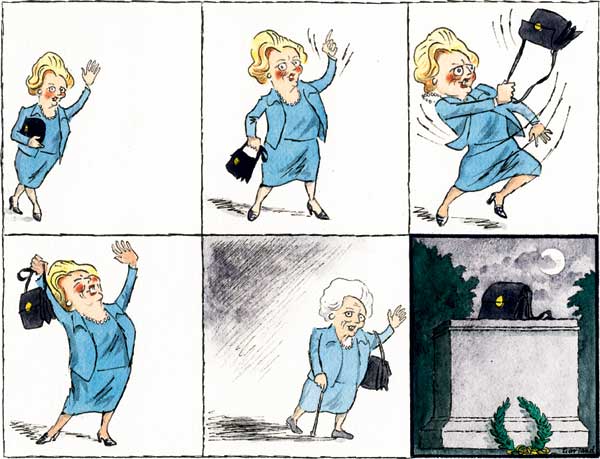The day Mrs Thatcher became Leader of the Opposition was a nightmare. Her victory over Mr Heath meant that I had to do a cartoon featuring her for the next day’s Daily Telegraph. But her arrival had been so swift that I barely knew who she was, and had almost no idea what she looked like. I had a problem.
I don’t remember getting the photographs from her file in the picture library to draw from. My memory begins as I sat at my desk and looked through them. They were all close-ups of her teeth and upper gums, bared in smiles, under various pantomime ugly-sister hats. In those days, all Tory women wore peculiar hats most of the time. I did not have enough to go on. I struggled for hours to draw her likeness and I still feel the pain of my failure. In the end, the best I could do was a caricature of one of her hats.
By studying television, newspaper photographs, and the clever work of other cartoonists in the coming weeks I figured out how to draw her, and I developed a hieroglyph that stood for Mrs. Thatcher. This is what political cartoonists, producing up to five cartoons a week, are forced to do. There is not time to come up with a new caricature every day.
Mrs Thatcher’s likeness lay in her complex bouffant hair-dos, downward-slanting eyes, strong cheekbones, pearls, and her shapely pursed lips. There were also the expressions that flickered over her face: sometimes stern and frowning, she could, in those early days, look uncertain and nervous.
Big Jim Callaghan appeared to be content to have her as his opponent, while, just off-stage right, Mr Heath nursed his rage and humiliation and threatened to go off at any minute with a gigantic bang. No wonder she looked uneasy at times.
One day, soon after her elevation, Mrs Thatcher visited the Daily Telegraph and sat in at the afternoon leader writers conference. She was much more chic than I had expected and perfectly relaxed. No. 10 advisers had already been at work. She was the only woman present, and she was treated with courtesy and respect, but what impressed me and amused me so much was the way she dominated the room, full of male leader writers, so completely. She flirted with them. In no time at all, they were all competing with each other, trying to impress her and perhaps win an approving nod… or even better, a smile.
Years later, when my left-wing friends expressed their hatred of her, I did not join in. Partly because of that afternoon, I did not hate her. I never thought she was evil.
As she left the conference, I was introduced to her, and she asked if the drawing, face-down on the table near me, was tomorrow’s cartoon. I showed it to her: it was something about the Liberals, and featured David Steel. She looked at it, and with mock firmness said, loudly, ‘Well! I’m not going to comment on that!’ Her playful response got a bigger laugh from the smitten leader writers than perhaps it deserved.
It was not long before she was smartened up, the way prime ministers often are these days. Think of how cool Tony Blair’s suits were, a year or two into office. Extensive dentistry improved MrsThatcher’s smile, her clothes, without the buttons and bows she once favoured, looked more City and less suburban, the preposterous hair-dos calmed down. She also worked on her naturally shrill, high-pitched voice, and invented a strange, cooing delivery along with her attempt at an upper middle-class accent. Her Professor Higgins never got rid of every glottal stop and the intonation always struck a false note. But on the whole she succeeded pretty well. She grew into a grand Tory lady in twinsets and pearls with a tendency to nag, as well as a very determined and skilful politician with a human touch; a flirt as well as the local headmistress.
As the years went by, and she became battle-scarred, I began to add a touch of panic to her piercing blue eyes. I never like to see an old champion fall, but the truth is, I grew tired of her in the end. She was Prime Minister for too long. As her colleagues abandoned her, and power slipped away, I wanted her to hurry up and go. That is, until the day she resigned when the House of Commons produced one of those tremendous theatrical moments that prove what a great spectator sport politics is.
By pure chance an Opposition no-confidence debate had been scheduled for that day. As her time ticked away, she grew stronger and stronger. She leant casually on the dispatch box and smiled at the Opposition benches. ‘Come on!’ she cried. ‘Come on — I’m enjoying this!’ And the House was enjoying it too. Her opponents were laughing along with her supporters. We had all been enjoying it in a way; things were going to be a bit duller from now on.






Comments